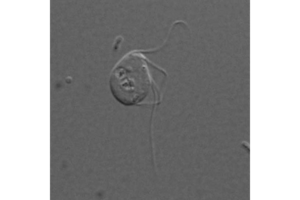Missing mitochondria: Strange eukaryotic cell lacks 'powerhouse'
Scientists have identified a living eukaryote that lacks mitochondria, thought essential for that type of cell to function.

This is a light micrograph of Monocercomonoides sp. (PA203).
Courtesy of Naoji Yubuki
In high school biology, you may have learned that one key difference between a eukaryotic cell and a prokaryotic cell is that one has mitochondria and the other doesn't.
But that may no longer be true.
A team of scientists have found a eukaryote with no mitochondria.
"Eukaryotic cells are defined by having mitochondria, so it's a big surprise for us that it's possible for a eukaryotic cell to still be viable without mitochondria," says Anna Karnkowska, a researcher at the Biodiversity Research Centre at the University of British Columbia, in an interview with The Christian Science Monitor.
To hunt for mitochondrial material, Dr. Karnkowska and colleagues sequenced the genome of Monocercomonoides sp., single-celled eukaryotes that resides in the guts of vertebrates. They were looking for proteins that are clear markers of the presence of mitochondria, but found none, according to the team's study published Thursday in the journal Current Biology.
Mitochondria are often called "the powerhouse of the cell" because they supply the cell with energy in the form of adenosine triphosphate (ATP). So how does a eukaryote survive without them?
Most energy generation requires oxygen, but not all eukaryotes live in oxygen-rich environments. This particular organism is anaerobic, meaning that it lives in the absence of oxygen – not all that surprising, considering it is a microbe that lives deep inside other animals.
So the mitochondria in anaerobes are already not classic mitochondria in the sense that they don't act exactly the ones in our cells, explains Karnkowska. But mitochondria serve other purposes, too.
Mitochondria are also involved in the vital formation of iron-sulfur proteins. "The eukaryotic cell basically cannot exist without iron-sulfur proteins," she says.
So the team hunted for evidence of a mitochondrial iron-sulfur cluster assembly pathway. This mechanism would be indispensable in a eukaryotic cell.
Or so the scientists thought, until they found no evidence of such a mechanism in this eukaryote.
That doesn't mean the organism is surviving without iron-sulfur proteins. However, that piece of the puzzle is a bit more complex.
Prokaryotes can assemble iron-sulfur clusters without mitochondria. So Karnkowska and her colleagues suspect that this eukaryote picked up a prokaryote's system through a process called horizontal gene transfer, also known as lateral gene transfer. Horizontal gene transfer (HGT) happens when an organism receives genes directly from another organism rather than from parent to offspring.
Once Monocercomonoides acquired that system, a cytosolic sulfur mobilization system (SUF), from a bacteria via horizontal gene transfer, Karnkowska suggests, the mitochondria likely became unnecessary for the eukaryote to function, so the organelle disappeared over generations.
Among scientists studying eukaryotic evolution, this finding may not be shocking, says Gertraud Burger, a researcher at the Robert-Cedergren Center for Bioinformatics and Genomics at the University of Montreal who was not part of the study.
Still, "I'm happy that it was found," she tells The Christian Science Monitor. It fits in a "series of strange eukaryotes that we see."
Other organisms, including many in the same family with Monocercomonoides, have been found with few mitochondria. So this one, Dr. Burger says, "is just the endpoint of the other forms that we have seen before."
"Usually we think of evolution like evolving ahead to diverge to become more complicated or complex," she says. "But there's also a very important trend of reductive evolution." And this eukaryote fits right in.
In this case, the cell is becoming more primitive by losing its mitochondria.
Scientists have been hunting for an organism with no mitochondria for decades, says Karnkowska. Monocercomonoides was a good candidate in this search because it sits among organisms with remnant mitochondria on the eukaryote family tree.
But why look for such a strange cell? One reason could be to help explain early organismal evolution. How did organisms go from prokaryotes, simple single-celled organisms that are basically just bubbles of DNA and protein, in other words, bacteria and archaea, to the much more complex eukaryotes, which today range from single-celled organisms up to large animals such as elephants, giraffes, bears, and humans?
One explanation scientists have proposed is the archezoa hypothesis, says Burger. In that scenario, one single-celled organism, the ancestor to all eukaryotes, absorbed a prokaryote. That little prokaryote began working for the ancestral eukaryote, eventually becoming the mitochondria.
In theory, finding an organism that lacks mitochondria could mean discovering this ancestral cell. But this organism provides no support for that hypothesis, Burger says. "It's not the precursor of the eukaryotic cell as we know it, but it's rather a very, very derived form."
It's clear that Monocercomonoides is not ancestral for a few reasons. The cell is quite complex and still has a nucleus and other organelles. It is also well situated on the Eukaryote family tree. But perhaps most importantly, Monocercomonoides resides within the gut of vertebrates, which themselves are multicellular eukaryotes. So it's unlikely that this organism could have evolved before that environment existed.
When the search began, the team wasn't sure if they would find any trace of a mitochondrion in this organism.
"We didn't know exactly how it would be with this one," Karnkowska says. "This is a great example of how weird a eukaryotic cell can be."

